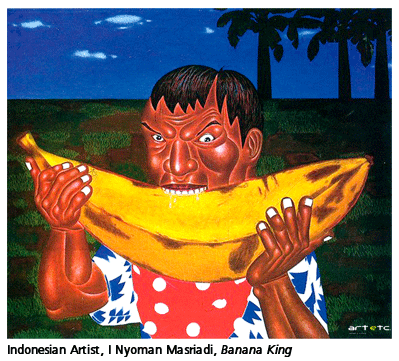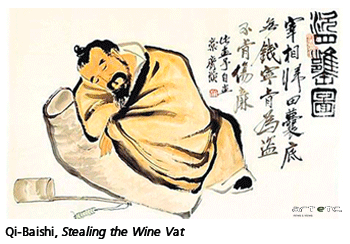- Publisher's Note
- Editorial
- Guerrilla Girls: The Masked Culture Jammers of the Art World
- Creating for Change: Creative Transformations in Willie Bester’s Art
- Radioactivists -The Mass Protest Through the Lens
- Broot Force
- Reza Aramesh: Action X, Denouncing!
- Revisiting Art Against Terrorism
- Outlining the Language of Dissent
- In the Summer of 1947
- Mapping the Conscience...
- 40s and Now: The Legacy of Protest in the Art of Bengal
- Two Poems
- The 'Best' Beast
- May 1968
- Transgressive Art as a Form of Protest
- Protest Art in China
- Provoke and Provoked: Ai Weiwei
- Personalities and Protest Art
- Occupy, Decolonize, Liberate, Unoccupy: Day 187
- Art Cries Out: The Website and Implications of Protest Art Across the World
- Reflections in the Magic Mirror: Andy Warhol and the American Dream
- Helmut Herzfeld: Photomontage Speaking the Language of Protests!
- When Protest Erupts into Imagery
- Ramkinkar Baij: An Indian Modernist from Bengal Revisited
- Searching and Finding Newer Frontiers
- Violence-Double Spread: From Private to the Public to the 'Life Systems'
- The Virasat-e-Khalsa: An Experiential Space
- Emile Gallé and Art Nouveau Glass
- Lekha Poddar: The Lady of the Arts
- CrossOver: Indo-Bangladesh Artists' Residency & Exhibition
- Interpreting Tagore
- Fu Baoshi Retrospective at The Metropolitan Museum of Art
- Random Strokes
- Sense and Sensibility
- Dragons Versus Snow Leopards
- What Happened and What's Forthcoming
- Art Events Kolkata, February – March 2012
- Mumbai Art Sighting
- Art Bengaluru
- Delhi Dias
- Musings from Chennai
- Preview, March, 2012 – April, 2012
- In the News, March 2012
- Cover
ART news & views
Sense and Sensibility
Issue No: 27 Month: 4 Year: 2012
Market Monitor
by Art Bug
As we embark upon the new financial year, statistics show and pundits predict alike: that the art market in 2012 will be robust but immensely competitive and that there may be a need to nurture new markets that are yet to be explored. The popular notion, that China is the biggest growing art market stands, but at the same time there is no reason to expect that the European and American market have taken a beating. In fact, according to hard statistics that are published after corroborating sales figures at auction houses throughout 2011, the Artprice Artmarket Trends 2011 show that during last year, the revenue collected has set a record in the decade. “… in spite of the sword of Damocles hanging over the West, art in fact sold better in 2011 than at any other time in history with $11.57 billion in total global annual revenue, up $2 billion versus 2010, which already produced the best performance of the decade. This increase was not solely generated by the Chinese market’s 49% growth compared with 2010; it represented overall growth… including European market. Indeed, the leading European auction markets posted strong figures: +24% in the UK ($2.24 billion in 2011 vs. $1.81 billion in 2010), +9% in France ($521 million vs. $478 million in 2010) and +23% in Germany ($213.9 million vs. $174 in 2010). In the Top 5 market places, only the USA contracted with a revenue total of $2.72B, down 3% vs. 2010.”
This becomes a significant observation in the context of the Euro crunch. In fact, after the meltdown three years back, in the latter half 2011, it was Europe which was faced with another threat of economic slowdown. Thus, the figures here are surprising, since the contraction actually happened in the American market, while the European centres have posted positive growth trends, topping their previous records.
Market experts, gallery owners and auction specialists ascribe this apparently curious scenario to the caution excercised by the buyers, as well as the availability of technology like telephone and online bidding, the latter making it easier for anybody anywhere in the world to take part in an auction, eliminating geographical limitations. The European market has leveraged this facility. The primary reason perhaps is the arrival of more numbers of new and young collectors in Europe than in America. “In Europe, 2011 was a very good year. We saw many new, younger collectors arrive, looking not only for young artists but also for established ones,” Karsten Greve who has galleries in Cologne, Paris, and St. Moritz told the Blouin Artinfo. There is another aspect of this decentralization that was pointed out to the Blouin Artinfo by Lorenzo Rudolf, the CEO and director of Art Stage Singapore, which debuted in 2011. He said, “The art world no longer has just two or three global centers. China might be the market locomotive right now, but there is interesting art in every country. Go to Vietnam, go to Cambodia—it’s like China 15 years ago. In 10 years the most interesting scene will be Burma.
 “In the past six months, at least two dozen collectors and curators have called me and asked for addresses of artists’ studios in Indonesia. I am sure that very soon some of the big Western galleries will be doing shows of Indonesian artists.”
“In the past six months, at least two dozen collectors and curators have called me and asked for addresses of artists’ studios in Indonesia. I am sure that very soon some of the big Western galleries will be doing shows of Indonesian artists.”
Some experts though have cited quality and blue-chip value of works on offer as the reason for the growth—which by numbers were offered more last year in the European market as compared to the auction floors of North America.
This brings us to the next observation—Blue-chip is big, and collectors and investors alike are thus accumulating at the top-end of the market. Artprice Artmarket Trends 2011 observed, “In 2011, the high-end market displayed an extraordinary dynamism. No fewer than 1,675 artworks sold above the $1 million threshold (including 59 above the $10 million threshold) representing a 32% increase of 7-figure (or more) auction sales versus 2010 and an increase of 493% versus the start of the decade! And it comes as no surprise that China posted by far the best national score with 774. Indeed, Hong Kong posted twice as many million-plus results as the entire Euro area! Further evidence of this exceptional health: the year saw no less than 12,400 new auction records for artists (excluding auctions debuts).”
Art-pundits predict that this trend is going to continue this year too. Emmanuel Di Donna, a former worldwide vice chairman at Sotheby’s, and a partner in Blain | Di Donna, which opened last year at the Carlyle hotel in New York, has been quoted by the Blouin Artinfo as saying, “More and more often art is looked at as something that gives great pleasure hanging on your walls but also as a good asset class—a good place to put some of your money. Collectors are looking for great works. What I saw this past year was that clients are price sensitive and quality sensitive, but the higher you go, the more quality sensitive they are. If you show somebody something really amazing, then price is not so much an issue, but if the quality is not A-plus, it needs to have the right price, at least in the private market.”
Nevertheless, art market analysts and predictors are bullish about the prospects of 2012. “I saw the market declines in the 1970s, ’80s, and ’90s, but I don’t see anything like that at the moment,” says Greve but adds, “Art as an investment is becoming more important here. Those collectors go mostly toward blue-chip works and the “hot list.” That is a bit silly, because just as with the stock market, going in the same direction as every-one else is profitable in the beginning, but not in the long run.”
 However, the summation of all that was perhaps best provided by the associate professor of finance at VU University in Amsterdam, and the author of Art+Auction’s Databank column, Roman Kraeussl. In his opinion, “what we saw this time was a small correction in the art markets. There was a 12-month dip around 2009. But there was not a slump of five or more years as when the Japanese bubble burst in 1991. We were saved because now the markets are much more globalized. The danger now will be if there is a shock to the Chinese economy, because so many of the markets are being driven by them at this point, at the high end as well as the midmarket level.”
However, the summation of all that was perhaps best provided by the associate professor of finance at VU University in Amsterdam, and the author of Art+Auction’s Databank column, Roman Kraeussl. In his opinion, “what we saw this time was a small correction in the art markets. There was a 12-month dip around 2009. But there was not a slump of five or more years as when the Japanese bubble burst in 1991. We were saved because now the markets are much more globalized. The danger now will be if there is a shock to the Chinese economy, because so many of the markets are being driven by them at this point, at the high end as well as the midmarket level.”
He further said to the Bluoin Artinfo that he does not see any immediate risk. “The wealth in China is growing more quickly now than in the U.S. and Russia combined. Throughout Asia, but especially in China, the number of high-net-worth individuals is continuing to grow and the amount of money available to each is also increasing. More and more of that is being invested in so-called emotional assets: artworks, but also wine, jewellery, watches and cars.
“There was fear that we might be entering a bubble again, but I don’t think so. The midmarket segment, from $50,000 to $1 million, might get punished a bit in the next couple of seasons. But the real expensive pieces will hold value. Up through 2008 I predicted India would have a similar boom. But I didn’t realize how much of the Indian market was being driven by Westerners speculating. This is the advantage in China: They are buying back their own culture. And it is not just a fad; they will be buying that back for a long time.”
And that is where the focus again shifts to China—a market which everybody in the art world is looking at with great expectations. However, it may be good to remember that putting one’s eggs in one basket has always been a risk and the auction houses need to realize this from their past experiences in America. It may be good to look for other potential markets like Indonesia and Japan, like Lorenzo Rudolf has suggested. Or for that matter also keep a healthy tab on the middle-eastern markets, which had, in the worst years of this decade not only been accommodating to global auction houses (unlike China) but has also been one of their sources of sustenance during those hard times.